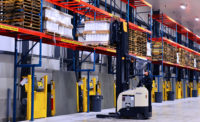
Editor’s note: Refrigerated & Frozen Foods went straight to the source to learn about the latest in automated storage and retrieval system technologies. Following is a discussion with Nobo Morita, executive vice president with Daifuku America Corp., Salt Lake City, Utah; Cory Flemings, executive sales manager with SSI Schaefer Systems International Inc., Charlotte, N.C.; and Percy May, director of crane systems sales for FKI Logistex, St. Louis.
Refrigerated & Frozen Foods:We last profiled automatic storage and retrieval systems (ASRS) in 2007. What has your company been up to during the past 12 to 18 months?
Nobo Morita: Daifuku just introduced a high-speed case handling ASRS system called the DUOSYS. We showcased it this September at the Logistec trade show in Tokyo. Sorting is the main purpose of the system, which features two storage retrieval machines running in the same aisle. The system has a capacity of 2,200 cases per hour.
Cory Flemings:We have two new technologies. The first involves our Schaefer Case Picking system, which can automatically select, optimize, palletize and stretch wrap mixed-SKU pallets for retail distribution. The whole system is a single, linear process that minimizes transfer points that can create errors and jams.
Customers’ orders are imported into our software, which “builds” the optimal pallet stack patter - considering crush class, family groupings and aisle sequence - in virtual reality before picking starts. Once the pallet is defined, we feed the exact sequence of the needed products to our ASRS system and we start selecting the cartons in the exact-needed sequence. The system knows where individual cases are, the exact dimensions of each case and the pallet loading pattern and sequence. At the end of the collection line, a palletizing robot automatically palletizes and stretch wraps each order pallet.
The key to this is a technology we have to “de-layer” pallets and put layers of cases (without human intervention) on a captive tray, which travels into and out of the ASRS. The system works by picking off that tray. Compared to traditional manual processes where the average cost per unit shipped is about 48 cents, this system’s cost is below 20 cents a case.
This technology is not quite there yet for frozen applications, but will be within the next one to five years.
Our second technology involves a mobile rack solution that’s already been proven in frozen environments, down to nearly –30ºF. When not in use, the system closes up the space between the racks so there’s no aisle. When there is a need to retrieve product - say a pallet of frozen grape juice - a central computer directs the appropriate aisle to open, and an unmanned VNA forklift will locate and bring out the product. With this system, you can optimize the cube of your facility and almost double warehouse capacity. More importantly, you can take the people out of a frozen environment.
Percy May:We continue to look at the latest component developments to provide better and more efficient SR machines and systems. We also are heavily involved in producing the most efficient design of double deep storage and retrieval systems for specific applications in public freezer warehousing.
R&FF:Many private and public warehouse operators struggle for labor. How does your company address labor savings and return on investment?
Morita:By installing an ASRS, users can remove personnel from picking in a freezer environment. This can increase productivity.
Flemings: SSI Schaefer combines its deep product portfolio with European product-to-picker (P2P) logistics concepts and technologies to either automatically pick or bring the goods to the picker.
Meanwhile, our approach removes stock from the floor and puts it into the air. This saves floor space for people and transport and reduces your building footprint. Reduced footprint yields shorter travel distances, which results in higher pick performance and fewer full-time workers needed. This approach also means you need less land for an operation. It also results in lower taxes, operational costs, etc.
I’d note that automation needs some time and volume to pay off. Frozen third-party warehouse contracts tend to be longer - and are certainly long enough - to hit an ROI because frozen facilities are capital intensive, even in a manual environment.
May:We continue to look at each customer application and evaluate - with simulation and application engineering - to see if automation is the right answer. Naturally, it is much easier to justify for 24-hour manufacturing applications and where the handling requirement is only full pallets. However, it also definitely is possible to provide automated case handling, palletizing and de-palletizing. However, it is always worth the investigation before decisions are made on the building and handling methodology.
R&FF: In your opinion, what are a few of the biggest misperceptions about ASRS use in a food plant or third-party warehouse? How do you address those concerns?
Morita: Initial cost and flexibility are most often mentioned. Although the initial cost is higher, we’re certain that reduced land requirements and operating costs often can offset that initial cost differential.
Flexibility in ASRS design is directly related to the adoption of a standard pallet size in the United States. We are close with the GMA pallet size 40-inches by 48-inches. Almost all systems designed to handle pallet loads are handling the GMA-sized loads. As long as this size is used, the ASRS can handle any type of product that fits this base size.
Heights can be changed within an ASRS structure, although it requires more effort. Planning up-front with the customer to determine the heights to be used is critical to provide the required flexibility.
It’s an added cost but including a captive pallet - on which the inbound load is placed upon entry into the ASRS - provides additional flexibility to be able to handle multiple in-bound pallet types and sizes.
Flemings: The biggest misperceptions are that it’s expensive and cannot pay off economically. On the contrary, we think you should compress the footprint and use the floor for transport because concrete still costs about $60 per square foot.
We run cost comparisons between conventional and automated facilities. You could easily spend $15 million for a 13-mile conveyor system. On the other hand, wouldn’t it be better to have just three miles of conveyor and invest the rest in a technology that actually picks for you?
May:High initial cost and lack of flexibility still are the two main misperceptions. Both capital outlay and potential savings/costs have to be evaluated for a full understanding of the investment. In regard to flexibility, it is possible to build flexibility into automation. I have just visited one of our automated installations in Europe where three sizes of loads are handled and stored by the cranes and conveyor in conventional double deep racks.
R&FF: Can you share any project success stories involving temperature-controlled food plants or public refrigerated warehouses?
Morita: There are a number of recent examples to mention. The most unique is an automated production facility for nameko mushrooms in Japan. In this facility, growing matter is stored at various controlled temperatures for incubation, germination and growing. In this case, ASRS systems have reduced the production staff from 50 to 12 people.
Another example involves the Nippon Access Hokkaido facility in Sapporo. The majority of this facility is kept below freezing. Storage, sorting and picking take place in a climate-controlled environment to ensure product integrity is maintained. The facility uses ASRS, a Jet Surfing Sorter and Sorting Transfer Vehicles (STVs). The company has tripled its volume and eliminated errors using one-third the labor.
Our final example, Hutechnorin Co. Ltd., incorporates three stories of cold storage space and automated equipment. The distribution center consolidates products on behalf of a co-op. Between the ASRS and the Mobile Rack (product not available in U.S.), the facility handles 1.2 million cases each month. Automation has helped the company drastically reduce sorting errors to just three out of every 100,000.
May: We have sold two further systems into the freezer storage business: Innovative Cold Storage in San Diego and more recently, Ruggiero Seafoods in Newark, N.J. In both cases the clients have chosen to go higher than traditional fork truck operation and use the AC-powered Condor from FKI Logistex on the basis that it provides a better storage solution coupled with a more cost effective operation. The goal is to save square feet and wasted freezer space.

